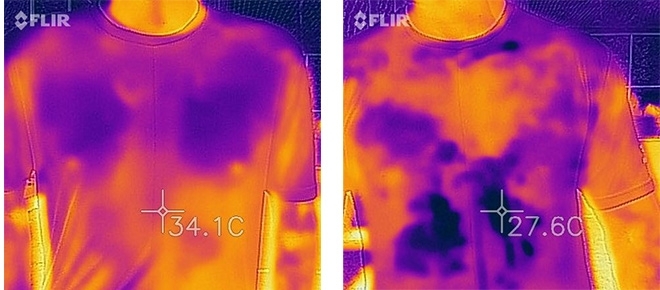

Brazilian firm has developed nanoparticles that eliminate body odor, reflect solar radiation, and release insect repellent and insecticide in fabric (images: Nanox)
Brazilian firm has developed nanoparticles that eliminate body odor, reflect solar radiation, and release insect repellent and insecticide in fabric.
Brazilian firm has developed nanoparticles that eliminate body odor, reflect solar radiation, and release insect repellent and insecticide in fabric.

Brazilian firm has developed nanoparticles that eliminate body odor, reflect solar radiation, and release insect repellent and insecticide in fabric (images: Nanox)
By Elton Alisson | Agência FAPESP – Functional fabrics that are due to be marketed next summer retain less heat, control body odor, protect against sunlight, and repel mosquitoes such as Aedes aegypti, which transmit pathogens that cause dengue, yellow fever, chikungunya and Zika.
Garments with this functionality use technology developed by Nanox Tecnologia S.A., a startup supported by FAPESP’s Innovative Research in Small Business Program (PIPE). The nanotechnology company is a spinoff from the Center for Research and Development of Functional Materials (CDMF), one of the Research, Innovation and Dissemination Centers (RIDCs) funded by FAPESP.
In partnership with textile manufacturers, Nanox is developing nanometric particles with different properties, such as controlling the microorganisms that produce body odor, reflecting electromagnetic radiation from the Sun, and releasing insect repellent in a controlled fashion.
“We have a number of projects in progress with textile companies. Several are in the final stages of production of fabrics with these properties,” Daniel Minozzi told Agência FAPESP. Minozzi is Nanox’s co-founder and chief operating officer.
The nanoparticles developed by Nanox are made of different inorganic materials and can be added to fabric individually or in combinations to confer the desired properties. Body odor, for example, is controlled by bactericidal, antimicrobial and self-sterilizing nanoparticles containing silver, zinc and copper.
When the nanoparticles are added to fabric fibers, they protect the material against the bacteria, fungi and mites that cause unpleasant smells. They also prevent yellowing of the fabric, according to Nanox.
“One of the advantages of these antimicrobial nanoparticles over other chemicals added to commercially available anti-odor textiles is their enhanced resistance to washing, temperature and abrasion,” Minozzi said.
“They also have less environmental impact, and they’re anti-allergic, so they can be used in any type of fabric that comes into direct contact with skin, such as the material for regular clothing, sports apparel, underwear, bed sheets, towels, and military or security uniforms.”
Nanoparticles that protect against solar radiation and improve thermal comfort can be used in curtains, everyday garments, sportswear and beachwear, as well as apparel worn by workers exposed to sunlight for long periods.
The nanoparticles consist of hollow glass microspheres coated with a thin, transparent nanostructured film made of zinc oxide, aluminum or titanium. These nanostructured materials act as micromirrors that reflect infrared and ultraviolet light, blocking the light from penetrating the fabric. As a result, they are capable of reducing thermal transmittance (heat transfer to the fabric) by up to 65% at wavelengths of 500-4,000 nanometers.
The technology was developed as part of a project supported by FAPESP via PIPE.
In tests performed by Nanox, a fabric containing its customized nanoparticles and exposed to sunlight achieved a temperature reduction of 6.5 °C compared to the same fabric without the nanoparticles.
“The fabrics available today for protection against sunlight are only able to block ultraviolet rays,” Minozzi said. “The nanoparticles we’ve developed also reflect infrared rays, making the fabric cooler for use during the day. The technology is totally innovative.”
The firm’s nanoparticle technology for protection against flying and crawling insects represents an incremental innovation, he explained. Nanox does not disclose details of the technology for industrial secrecy reasons. However, it does say the innovation is in the system for containing repellent or insecticide molecules inside the nanoparticles and their fixation to the fabric.
“Some of the main issues currently complicating the addition of repellent to fabrics are repellent odor and postwash fixing. We’ve developed a system that overcomes these issues when insecticide or repellent is included to fabrics,” Minozzi said.
Bactericidal nanoparticles
The nanoparticles with bactericidal, antimicrobial and self-sterilizing properties developed by the firm are currently used in a range of products, including plastic utensils, PVC film for food wrapping, toilet seats, shoe insoles, hair dryers and flatirons, paints, resins, and ceramics, as well as coatings for medical and dental instruments such as grippers, drills and scalpels.
Today, the company’s largest markets are makers of white goods such as refrigerators, drinking fountains and air conditioners, as well as rugs and carpets.
“We’ve supplied the carpet and rug industry for eight years, so our effective entry into the textile segment now is a natural move,” Minozzi said.
Nanox currently exports via local distributors to Chile, China, Colombia, Italy, Mexico and Japan, among others, and recently opened a subsidiary in Boston (USA).
“We need a US branch to facilitate and accelerate the pursuit of a license to sell our product there. The licensing process is in the final stage of evaluation for approval,” Minozzi said.
Republish
The Agency FAPESP licenses news via Creative Commons (CC-BY-NC-ND) so that they can be republished free of charge and in a simple way by other digital or printed vehicles. Agência FAPESP must be credited as the source of the content being republished and the name of the reporter (if any) must be attributed. Using the HMTL button below allows compliance with these rules, detailed in Digital Republishing Policy FAPESP.





